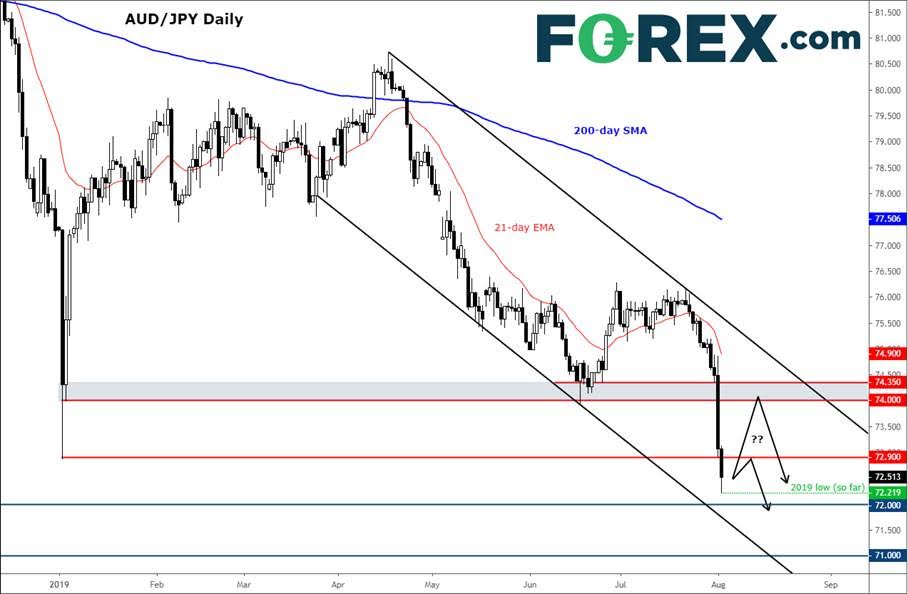The week ahead features interest rate decisions from two major central banks, as well as several potentially market-moving data from around the world. But after US President Donald Trump brought trade tensions back to the boiling point this week, sentiment is going to be heavily influenced by any trade-related headlines in the early parts of the week, with China already saying it will retaliate. Indeed, there was a possibility that the President would announce EU tariffs on Friday, in a speech scheduled for 18:45 (13:45 ET).
Besides trade wars, the somewhat disappointing US jobs report published on Friday has also increased the likelihood of another rate cut from the Fed. So, don’t be surprised if the dollar were to weaken further in early next week, especially against haven currencies such as the Japanese yen and gold. But there will be plenty of global data that will move foreign currencies. Here are some of the data highlights:
Monday
- Flash services PMIs from UK and US (ISM), and final PMIs from Eurozone countries.
Tuesday
- New Zealand quarterly employment change (late in the evening on Monday for UK/US investors)
- RBA
- German factory orders
Wednesday
- RBNZ
- German industrial production
Thursday
- China trade balance
Friday
- Japan GDP
- German trade figures
- UK GDP, manufacturing production and construction output
- Canadian employment figures
- US PPI
US dollar could fall further
After the Fed’s latest rate cut, the market is now 98% sure we will see a follow-up cut in September, according to the CME’s FedWatch tool, despite the central bank giving out a not-so-dovish signal on Wednesday. As such, upcoming US (and global) economic data will be crucial over the next month and a half. Unfortunately, apart from the ISM non-manufacturing PMI on Monday, there isn’t a lot on the agenda in terms of US data next week. Still, the markets will be wondering whether the escalation in US-China trade dispute may increase the odds for further rate cuts anyway. The dollar has already fallen sharply since Trump tweeted about the additional tariffs. Indeed, according to Capital Economics, the tariffs are likely to cause a sharp slowdown in economic growth over the second half of the year, which is “another reason to expect the Fed to cut interest rates by a further 50bp by early 2020.”
RBNZ expected to cut
As far as the two central banks are concerned, the Reserve Bank of New Zealand (RBNZ) is widely expected to cut rates 25 basis points to 1.25% from the current 1.50% rate. This wouldn’t come as major surprise, although to what degree the NZD will respond will depend almost entirely to the forward guidance. If the RBNZ signals further rate cuts might be on the horizon then the NZD could fall sharply, whereas if it signals that it is a one and done cut, then in this case the commodity dollar could respond positively, despite the expected rate cut.
RBA policy change uncertain
There is less certainty as far as the Reserve Bank of Australia (RBA) is concerned, which cut rates to just 1.0% last month. The probability for another 25-basis point cut is around 50%. So, whatever the RBA does, there will be a group of market participants that will be disappointed/surprised. Therefore, the AUD could move sharply on the announcement.
Featured chart: AUD/JPY
With risk being off the menu and the potential for a RBA rate cut, the AUD/JPY could very well drop further during the week. But if the RBA decides against a rate cut, then a short squeeze could be on the cards on Tuesday. Still, the trend is bearish, so we favour fading the rallies. The first level of daily resistance comes in at 72.90 then there is nothing significant until 74.00-74.35 area. These levels were previously support.

Trading leveraged products such as FX, CFDs and Spread Bets carry a high level of risk which means you could lose your capital and is therefore not suitable for all investors. All of this website’s contents and information provided by Fawad Razaqzada elsewhere, such as on telegram and other social channels, including news, opinions, market analyses, trade ideas, trade signals or other information are solely provided as general market commentary and do not constitute a recommendation or investment advice. Please ensure you fully understand the risks involved by reading our disclaimer, terms and policies.
Recommended Content
Editors’ Picks
EUR/USD retreats below 1.0700 after US GDP data

EUR/USD came under modest bearish pressure and retreated below 1.0700. Although the US data showed that the economy grew at a softer pace than expected in Q1, strong inflation-related details provided a boost to the USD.
GBP/USD declines below 1.2500 as USD rebounds

GBP/USD declined below 1.2500 and erased the majority of its daily gains with the immediate reaction to the US GDP report. The US economy expanded at a softer pace than expected in Q1 but the price deflator jumped to 3.4% from 1.8%.
Gold holds near $2,330 despite rising US yields

Gold stays in positive territory near $2,330 in the second half of the day on Thursday. The benchmark 10-year US Treasury bond yield is up more than 1% on the day above 4.7% after US GDP report, making it difficult for XAU/USD to extend its daily rally.
XRP extends its decline, crypto experts comment on Ripple stablecoin and benefits for XRP Ledger

Ripple extends decline to $0.52 on Thursday, wipes out weekly gains. Crypto expert asks Ripple CTO how the stablecoin will benefit the XRP Ledger and native token XRP.
After the US close, it’s the Tokyo CPI

After the US close, it’s the Tokyo CPI, a reliable indicator of the national number and then the BoJ policy announcement. Tokyo CPI ex food and energy in Japan was a rise to 2.90% in March from 2.50%.